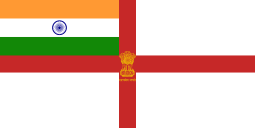Khukri-class corvette
The Khukri-class corvette is a class of corvettes intended to replace the ageing Petya II-class corvettes of the Indian Navy.
INS Kuthar | |
| Class overview | |
|---|---|
| Name: | Khukri class |
| Builders: |
|
| Operators: |
|
| Preceded by: | Veer class |
| Succeeded by: | Kora class |
| In commission: | 1989–present |
| Planned: | 4 |
| Completed: | 4 |
| Active: | 4 |
| General characteristics [1] | |
| Type: | Corvette |
| Displacement: | 1,423 short tons (1,291 t) (full load) |
| Length: | 91.1 m (299 ft) |
| Beam: | 10.5 m (34 ft) |
| Draught: | 4 m (13 ft) |
| Propulsion: | 2 × SEMT Pielstick/Kirloskar 18 PA6V 280 diesel engines (14,400 PS, 10,600 kW); 2 shafts |
| Speed: | 24 kn (44 km/h; 28 mph) |
| Range: | 4,000 nmi (7,400 km; 4,600 mi) at 16 kn (30 km/h; 18 mph) |
| Complement: | 112 including 12 officers |
| Sensors and processing systems: |
|
| Electronic warfare & decoys: |
|
| Armament: |
|
| Aircraft carried: | 1 × HAL Chetak or HAL Dhruv |
The first two were ordered in December 1983 and the remaining in 1985. Around 65% of the ship contains indigenous content.[1] The diesel engines were assembled in India, under license by Kirloskar Group.
Ships of the class
| Name | Pennant | Builder | Homeport | Laid down | Launched | Commissioned | Status |
|---|---|---|---|---|---|---|---|
| INS Khukri | P49 | Mazagon Dock Limited | Visakhapatnam | 27 September 1985 | 3 December 1986 | 23 August 1989[1] | Active |
| INS Kuthar | P46 | 13 September 1986 | 15 April 1989 | 7 June 1990[1] | |||
| INS Kirpan | P44 | Garden Reach Shipbuilders and Engineers | 15 November 1985 | 16 August 1988 | 12 January 1991[1] | ||
| INS Khanjar | P47 | 15 November 1985 | 16 August 1988 | 22 October 1991[1] |
gollark: Who pinged me?
gollark: A ghast (inside the lava stream) has come to complain about environmental damage.
gollark: Yep!
gollark: Quarrying!
gollark: I mean, usually they're probably a few gigabytes at most, so either that desktop is terrible or they're getting uselessly worried about stuff.
See also
References
- Commodore Stephen Saunders, ed. (2005). "India". Jane's Fighting Ships 2005-2006 (108th ed.). Coulsdon: Jane's Information Group. p. 322. ISBN 0710626924.
This article is issued from Wikipedia. The text is licensed under Creative Commons - Attribution - Sharealike. Additional terms may apply for the media files.
